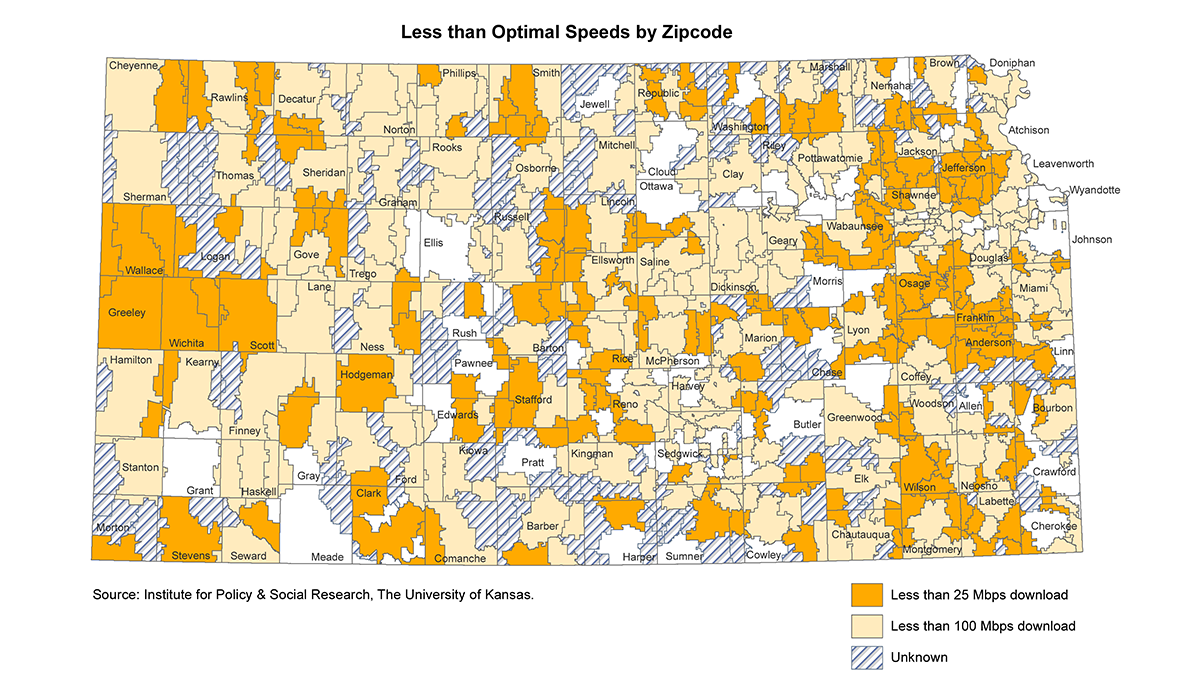Speed test surveys show 1 million Kansans may have inadequate internet

LAWRENCE — Two surveys conducted by researchers at the University of Kansas Institute for Policy & Social Research from January 2021 to January 2022 found that over 1 million Kansans live in a ZIP code where recorded average download speeds are below 100 Mbps download /20 Mbps upload. Those speeds are considered an adequate baseline for people engaged in online education, streaming video, downloading and uploading large files, and households with multiple users. This finding is especially relevant given the increase in remote work, online schooling and need for access to online services and resources during the COVID-19 pandemic.
The surveys have identified areas of the state where internet speeds do not meet the current FCC minimum definition of broadband at 25 Mbps download and 3 Mbps upload. The surveys also identified areas that fall below a more robust standard of 100 Mbps download and 20 Mbps upload.
“The COVID-19 pandemic showed us that access to broadband is essential for work and education. Our surveys indicate that far too many Kansans do not have access to high-speed internet services. Kansas is in the process of making significant investments in broadband infrastructure that will support future economic growth and development in the state," said Donna Ginther, principal investigator on the project, Roy A. Roberts Distinguished Professor of Economics and director of IPSR.
The surveys involved a questionnaire about at-home broadband access, affordability and adoption as well as a speed test to automatically report the speed of respondents’ internet connection. Survey data was used to map Kansas internet speeds across the state to help policymakers, service providers and residents identify unserved or underserved areas. Over 6,800 Kansans responded to the surveys.
This study is being conducted with external funding from the U.S. Economic Development Administration University Center CARES Act. The study team includes Ginther; Germaine Halegoua, John D. Evans Development Professor & Associate Professor of Communication and Media, University of Michigan; and IPSR staff members Xan Wedel, Genna Hurd and Thomas Becker.
Of the 557 Kansas ZIP codes identified among respondents, the study also found that 95 ZIP codes had an average recorded speed falling short of the FCC broadband definition of 25/3 Mbps. These ZIP codes represent 87,000 people, or 3% of the total Kansas population.
“It’s well known that 25/3 is already an outdated baseline for adequate internet connection and will only prove more inadequate as internet needs increase. The fact that at least 3% of Kansans don’t even have this subpar connection is alarming. It’s like saying that 3% of the population lacks access to any other utility. It’s a disadvantage not only to these households and communities, but a disadvantage to the state of Kansas,” Halegoua said.
This finding is comparable to data reported by internet providers to the FCC, which indicates that 2.4% of Kansans live in Census blocks where internet providers report average speeds of less than 25/3 Mbps. The maps of speed tests across the state show that inadequate access to broadband internet service at home is not exclusively a rural issue but affects households in urban and urban-adjacent areas as well.
“The maps confirm that rural and frontier populations definitely struggle with unreliable or nonexistent internet access which affects their livelihoods, access to education and much-needed telehealth services. Our maps also show that households right on the edge of city limits also lack adequate access. As someone who lived just outside Lawrence city limits for nearly 10 years, I know this to be true. But even I didn’t realize that this was such a common statewide experience until I saw our maps,” Halegoua said.
In addition to surveys, researchers conducted interviews and focus groups to learn more about internet experiences across the state. The research team plans to release the full results of the study later this spring.
Image: Map of Kansas showing data on download speed by area. Significant portions of the state have average speeds lower than 25 Mbps download, and significant portions of the state have average speeds lower than 100 Mbps download. Source: Institute for Policy & Social Research.